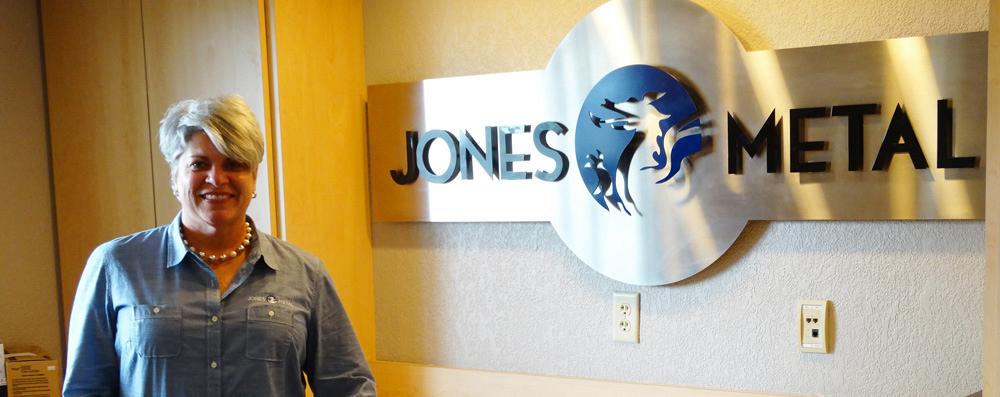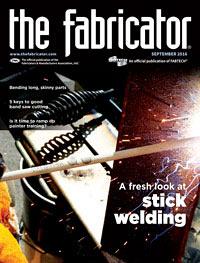Senior Editor
- FMA
- The Fabricator
- FABTECH
- Canadian Metalworking
Categories
- Additive Manufacturing
- Aluminum Welding
- Arc Welding
- Assembly and Joining
- Automation and Robotics
- Bending and Forming
- Consumables
- Cutting and Weld Prep
- Electric Vehicles
- En Español
- Finishing
- Hydroforming
- Laser Cutting
- Laser Welding
- Machining
- Manufacturing Software
- Materials Handling
- Metals/Materials
- Oxyfuel Cutting
- Plasma Cutting
- Power Tools
- Punching and Other Holemaking
- Roll Forming
- Safety
- Sawing
- Shearing
- Shop Management
- Testing and Measuring
- Tube and Pipe Fabrication
- Tube and Pipe Production
- Waterjet Cutting
Industry Directory
Webcasts
Podcasts
FAB 40
Advertise
Subscribe
Account Login
Search
Winning new business in custom metal fabrication
Building new business takes time. Can it be streamlined?
- By Tim Heston
- September 14, 2016
- Article
- Shop Management

Sarah Richards, president and CEO of Mankato, Minn.-based Jones Metal, has spearheaded a rebranding and restructuring effort that aims to build a framework for future growth.
If you look at financial and other performance benchmarking metrics of custom metal fabrication, revenue concentration usually stands out.
Every year the Fabricators & Manufacturers Association International publishes its “Financial Ratios & Operational Benchmarking Survey.” In it, fabricators report how many customers make up at least 50 percent of their annual revenue. In many cases, you can count those customers on one hand.
Fabricators also report the number of new customers they’ve gained during the past year, and here you can see a shop’s sales efforts at work. The average number of new accounts has fluctuated between 16 and 18 since 2013. Of course, here’s the kicker: Altogether, those new customers provide just 5 to 6 percent of a fabricator’s annual revenue.
There’s a lot of talk about diversification in custom metal fabrication, but the market reality is that it usually takes time, and a great deal of relationship-building, to turn a new account into a major customer. That’s a challenge, particularly in such a capital-intensive business. A shop needs to grow revenue to expand, to invest in machinery, facilities, and often inventory, all of which allow a shop to respond quickly. For most shops, it’s easier to build revenue by satisfying the needs of current customers and, as a result, win more business from them.
There’s an obvious danger, which became abundantly clear for shops serving commodity sectors (food, oil and gas, mining, etc.) in 2015—and virtually any fabricator in 2008 and 2009. Many shops that grew on the backs of customers in specific industries just didn’t make it through the Great Recession. If it was lucky enough to be diversified in the right sectors, a fabricator could muddle its way through the hard times.
Shop owners and managers usually tackle the revenue-concentration conundrum in several ways. Some focus on industries that have a horizontal reach—that is, find customers who are themselves diversified. For instance, businesses offering material handling or packaging equipment have customers that span much of U.S. economic activity, from Amazon’s warehouses to automotive plants.
Second, fabricators attempt to streamline new business development; that is, finding a quicker way to turn a prospect into a major, long-term customer. Call it the “prospect-to-partner” cycle.
You can see evidence of such an effort when Sarah Richards, president and CEO of Jones Metal, hands you a business card. Above Jones Metal you see an all-caps logo in sleek san serif type: “BOXWORX.”
The name came about from a rebranding effort at the Mankato, Minn., custom fabricator. “We wanted to add to our [customer] portfolio,” Richards said. “To break into new industries, we knew we needed to become a sales organization. So when you go out into the marketplace, as a fabrication job shop, [prospects] ask, ‘Well, what do you do?’ Well, that question can stop you in your tracks. We do everything, essentially. If there’s something you can do with sheet metal in a certain range of thicknesses, we do it. Most [custom fabricators] can say the same thing.”
From a sales perspective, saying “we do everything” doesn’t leave a lasting impression, especially if a fabricator is one of many job shops that can claim the same thing. It also doesn’t paint a true picture of the company. Every successful fabricator has its strengths, and Jones Metal is no different.
Richards and her management team identified those strengths by asking straightforward questions, including What kind of work did the shop keep winning?
That’s easy: enclosures. The fabricator got its start in the 1940s as a sheet metal enclosure supplier for Kato Engineering’s electrical generators, among other products.
That work also involved close-knit design collaboration. Even today Kato (now owned by Emerson) relies on Jones to help design the sheet metal enclosures for its products. From this relationship came Jones’ robust engineering department. And to create these enclosures, of course, the company has significant laser cutting capacity.
From this analysis came the idea of a new company structure, with a parent company over several divisions. The first among these is Jones Metal Boxworx, which specializes in custom enclosures. The division aims to reach customers who would buy an off-the-shelf enclosure from a large company but can’t seem to find one to meet their needs in low quantities.
Here is where Jones Metal Boxworx fills a need. The goal is to offer services for handling a wide variety of custom, complex enclosures, as well as a standard line of customizable electrical enclosures.
Jones has reserved several other names that it hopes to use to tackle growth opportunities. First is Jones Metal Designworx, a division that focuses on the fabricator’s sheet metal design capabilities. Second is Jones Metal Laserworx, which brands the company’s laser cutting capabilities. And third is Jones Metalworx, a brand for future proprietary product lines, such as metal furniture.
Richards emphasized that all this is in the infancy stages. All the same, the new structure is providing the fabricator with a framework for future growth. When one of the fabricator’s sales reps visits a prospect, the “What do you do?” question won’t stop them in their tracks. Ideally, prospects will see the brand and not even need to ask the question.
Jones Metal, 800-967-1750, www.jonesmetalinc.com
About the Author

Tim Heston
2135 Point Blvd
Elgin, IL 60123
815-381-1314
Tim Heston, The Fabricator's senior editor, has covered the metal fabrication industry since 1998, starting his career at the American Welding Society's Welding Journal. Since then he has covered the full range of metal fabrication processes, from stamping, bending, and cutting to grinding and polishing. He joined The Fabricator's staff in October 2007.
Related Companies
subscribe now

The Fabricator is North America's leading magazine for the metal forming and fabricating industry. The magazine delivers the news, technical articles, and case histories that enable fabricators to do their jobs more efficiently. The Fabricator has served the industry since 1970.
start your free subscription- Stay connected from anywhere

Easily access valuable industry resources now with full access to the digital edition of The Fabricator.

Easily access valuable industry resources now with full access to the digital edition of The Welder.

Easily access valuable industry resources now with full access to the digital edition of The Tube and Pipe Journal.
- Podcasting
- Podcast:
- The Fabricator Podcast
- Published:
- 04/16/2024
- Running Time:
- 63:29
In this episode of The Fabricator Podcast, Caleb Chamberlain, co-founder and CEO of OSH Cut, discusses his company’s...
- Trending Articles
Capturing, recording equipment inspection data for FMEA

Tips for creating sheet metal tubes with perforations

Are two heads better than one in fiber laser cutting?

Supporting the metal fabricating industry through FMA

Omco Solar opens second Alabama manufacturing facility

- Industry Events
16th Annual Safety Conference
- April 30 - May 1, 2024
- Elgin,
Pipe and Tube Conference
- May 21 - 22, 2024
- Omaha, NE
World-Class Roll Forming Workshop
- June 5 - 6, 2024
- Louisville, KY
Advanced Laser Application Workshop
- June 25 - 27, 2024
- Novi, MI


























